| |||||||
 |
| Search this Thread |  145,520 views |
| | #1 |
| Team-BHP Support  | Why engine capacity-based diesel vehicle bans don't make any sense Over the last few months, we have seen a rash of activism from NGT to try and control vehicular emissions. Numerous orders have been passed, and two of them concern Automobiles
Among the public, this has evoked a mixed reaction. On one hand we have "environmentalists" who believe this is a good decision as diesel vehicles above 2000cc pollute the most. On the other hand we have enthusiasts and others, who claim that emissions are not dependent upon engine capacity. So who is right, and who is wrong? To answer that question, we have to understand, what was the target of the NGT decision. Emissions are of two types. The first type is Carbon Dioxide. The global warming gas. An efficient engine will produce less CO2. No rocket science there. If you want to make a decision to restrict CO2 decisions, you would ban all petrol cars. But clearly that was not done. So the decision is not about CO2 The second type is NOx/Hydrocarbons and PM(Particulate matter). In the judgement, the target has been reducing PM2.5 and PM10 emissions, as well as NOx and HC, which have reached dangerous levels in the capital region and other cities. Now, there is no debate that diesel vehicles contribute to PM10 and PM2.5 as well as NOx emissions. However, instead of banning all diesels, only those above 2000cc have been banned. So the question arises, is this ban logical? It is easy to cry hoarse, sing bards about conspiracy theories of the diesel lobby, or blame the NGT of not thinking at all. But crying hoarse does not provide any information. In all this debate, information has been very thin. Therefore, I set out to find information about emissions of various diesel vehicles. All countries require certain emission norms to be met. Year after year, you can have more and more stringent norms. Eg Euro V was adopted in Europe in 2009. India has now adopted Euro-IV or Bharat Stage IV in metro cities. So it should be a simple matter of going to ARAI website and downloading NOx and PM data of vehicles? Well no. ARAI is not an open data access corporation, and a dead end. So the next best thing is to go to Europe. Or UK to be specific. They provide emission data not only for new vehicles, but for older model years also. Data is provided year wise. Therefore, I went to the website http://carfueldata.dft.gov.uk/ and downloaded multiple data sets Euro IV data from May 2008 and May 2009 Euro VI data from August 2013 and August 2015 I also took a random sampling of some "used car" data. You have to keep meeting emission norms of your said model(eg EU IV) year after year. So this is test data. This varies from piece to piece. This data was taken for Euro IV. Since you cannot download all data in excel format, the data set is much smaller as it requires manual entry. Using these data sets I created scatter charts with NOx and Engine size. I did not use PM for primary analysisl, because for Euro 4 PM does not vary across vehicles and is quite low. There is no Euro 3 data available online as Europe went Euro 4 in 2000 itself. However, since older diesels still had some PM emissions, for sake of completeness, I have plotted data of Euro 4 vehicles from 2002. These engines are 15 year old tech, and not used anywhere now. But we can look at that dataset to see if PM varies with engine capacity. Euro 6 anyway have DPF, or diesel particulate filter. So no point in looking at that. At both Euro 6 and Euro 4, NOx+HC vs engine size can be easily used to determine if there is a correlation at all, and that will be the basis of our analysis The writing is literally on the wall. If you see data plots, you will see that for all engine capacities, NOx+HC emissions vary from lower end of the range to higher end of the range. 2008 Euro 4 data Lets look at the 2008 Euro 4 data. NOx+HC emissions are in g/km, and engine capacity in cc.
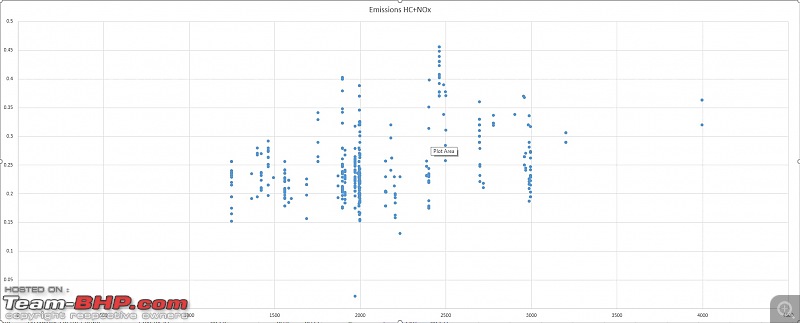 Euro 4 data plot 2009
 Euro 6 data plot 2013 Please note change in units to mg/km
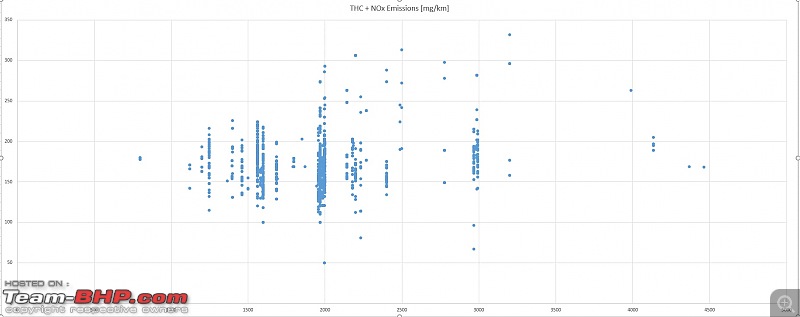 Euro 6 data plot 2015
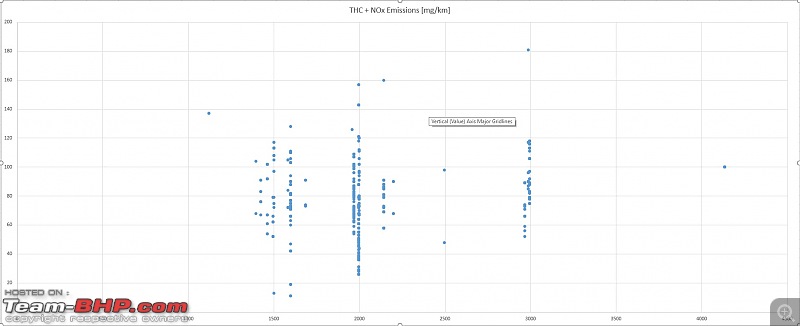 User car data May 2009 As mentioned before, this shows degradation based on use case. I wish there was a way to extract all data. A shout out to data miners. If you can pull all the data month wise, we can have a terrific data set. Variation in used car data set is much more Engine capacity is in L and emissions in mg/km
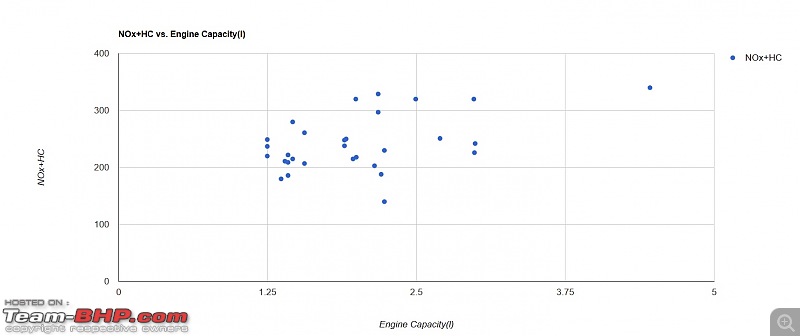 PM level vs engine size with data from 2002
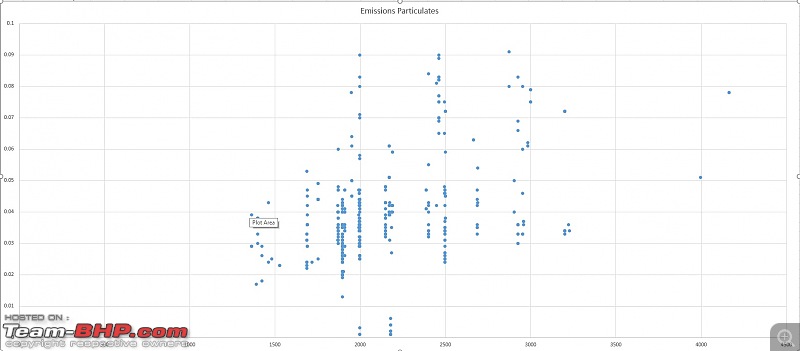 Observations from Euro 4 data(NOx+HC)
Engine size has little role to play in NOx and PM emissions. Emissions are dependent more upon engine design, and high power versions of smaller engines pollute much more. If NGT is serious about PM emissions, they should ban all vehicles without DPF fitted. This would get all small diesel cars banned in India. Only Luxury 2000c+ SUVs can be sold. As for as NOx+THC is concerned, NGT can ask ARAI to test all new cars and ban those found in the upper end of the range. However, Euro IV cars will be far less polluting than the Euro 3 or Euro 2. As a parting data shot, just take a look at the July 2000 data. See how much diesel cars have controlled pollution. This clearly shows, you control pollution by not arbitrary rules, but by legislation based on emission numbers. The story is the same though, 4L engines cleaner than 1.9xx exist! 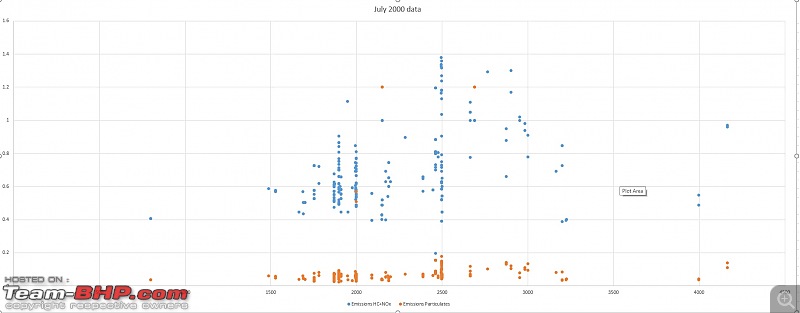 And the irony is, you can easily run your ill maintained 8 year old Euro 2 vehicle, but not buy an ultra clean Euro 4 compliant luxury SUV capable of Euro 6 with just a DPF. Last edited by Rehaan : 31st May 2016 at 18:07. Reason: As per RP |
| |  (201)
Thanks (201)
Thanks
 |
| The following 201 BHPians Thank tsk1979 for this useful post: | .anshuman, aaggoswami, Aaron:), abir.scot, Ace F355, Aceman82, achyutaghosh, ACM, adimicra, Aditya, ajman28, Akshay1234, AKTRACK, alpha1, ampere, amyth78, ani_meher, Aragorn, arundeep, arvind71181, ashlil, aviat18, avisidhu, Baddychat, bblost, bhaskaracs, BigBrad, biggrin, bigron, BlackPearl, BNM, BoneCollector, bsdbsd, catchjyoti, chaith.turbo, Chuckster, cn.vishnu, Contrapunto, coolrain, createrkid, cs_rajesh, d3mon, dean5545, deathwalkr, deepfusion, deetjohn, dhanushs, DicKy, Digital Vampire, Divya Sharan, djay434, doxinboy, DrANTO, drdeepudev, drhoneycake, Dushyanth, Eddy, Edwardanto, espraveen, ex670c, Games Goblin, ganeshb, gaurav_3000ad, GetLife, Gosu, GTO, harry10, hillsnrains, hybridpetrol, iamswift, Immix, InControl, indian21r, IndigoXLGrandDi, Jag4, Jaggu, Jeash.vk, josebi, jusgetgoing, Karthik Chandra, kestersujay, kiku007, kutts, laferrari, lamborghini, lloydofcochin, mac187, maglev, mallumowgli, manson, man_of_steel, mh09ad5578, mi2n, mmmjgm, moralfibre, Motard_Blr, motor_breathing, mrbaddy, mroptimist, namitkumar31, navpreet318, Nilesh5417, niv26, noopster, Omkar, onedotsix, PapaBravo, parsh, pdma, peterjim13, PGNarain, phamilyman, phoenixash, phynix123, pmbabu, praveen_v, prkiran, Prowler, purohitanuj, quickdraw, R2D2, Rachit.K.Dogra, raghu.bramha, rajblr, Rajeevraj, rambo1o1, RavenAvi, rednikhil, Rehaan, rishie, riturajsharma19, rkv_2401, RoadSurfer, RohanDheman, Rohit Manohar, rohitnp, rohitoasis, romeomidhun, rrsteer, Ruchitya, S2!!!, samabhi, samm, Samurai, samy1117, sandeepmohan, Sankar, sbala, scopriobharath, SDP, sdp1975, shibu, shipnil, shobhitk, shreyak_ss, Shreyans_Jain, silversteed, simplysaj, Sisu, SnS_12, sourav9385, spdfreak, sri2012, sridhar-v, Srikanthan, SS-Traveller, ssahadevan, stanjohn123, Sting, suhaas307, sups, swiftnfurious, Tamarind, Teesh@BHP, The Great, The Rationalist, theexperthand, TheSkinnyDevil, TheTeacher, ThomasZach, Tojo_GotBhp, Touringlawyer, Turbo Head, Turbohead, turboride, unmesh, vb-saan, vgsr, vibbs, Vid6639, Viju, viren83, Vishal.R, Vitalstatistiks, vpillai, Waspune, wrongturn, Yeldo, yjagota, Zahoor23, zavegur |
| |
| | #2 | |
| Team-BHP Support  | Some more data analysis Now we have taken a look at NOx+HC and PM data for Euro 4 and Euro 6, lets take it to the next level. After all, with so much data at our disposal, it makes sense to deep dive. First we will look at Carbon monoxide. Here is the problem with CO Quote:
In high traffic and industrialized areas, this is a big problem. There has been about 20-30% reduction in the past 30 years, but still a long way to go. So is it a problem for us in Metros? The answer is not difficult to find, thanks to the eyes in the sky. Here is a sample data overlay of Carbon monoxide.  Data sample taken 27 May 2016, 00:00 UTC Now, the second question, is it dependent upon engine capacity? Is it dependent upon fuel type(Petrol/Diesel). With the August 2015 data, again, the writing is on the wall. Petrol engines emit more CO than diesel engines. Engine CC does not matter, with some large engines emitting less CO than smaller ones. 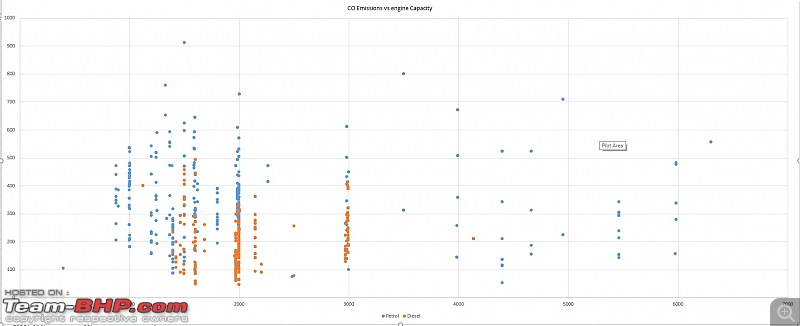 Moving on from CO, lets now go after the big bad villain of global warming - CO2. World over, cars are said to be the biggest evil in destroying the planet with climate change. As a result, in many countries your road tax depends upon the amount of CO2 your vehicle emits. So how does that scale with engine size? Well it does. Larger engines burn more fuel and emit more CO2, but again, petrol vehicles emit more CO2 than diesels. If NGT is after global warming, petrol engines should go 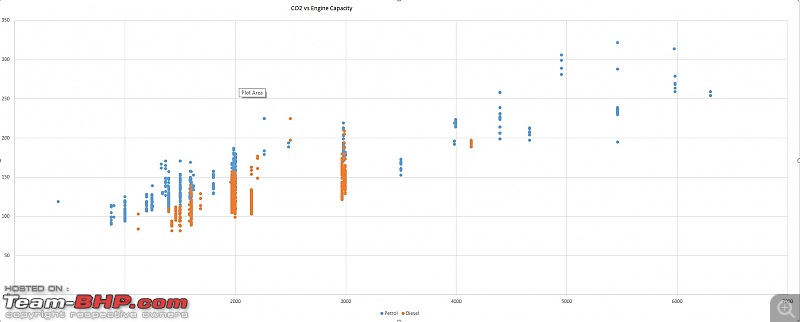 Last but not the least, lets shift gears from environment to fuel consumption. What if we want to conserve fossil fuels? What is the best option. Everybody says its diesel. Right? what does the data say? Here you go! 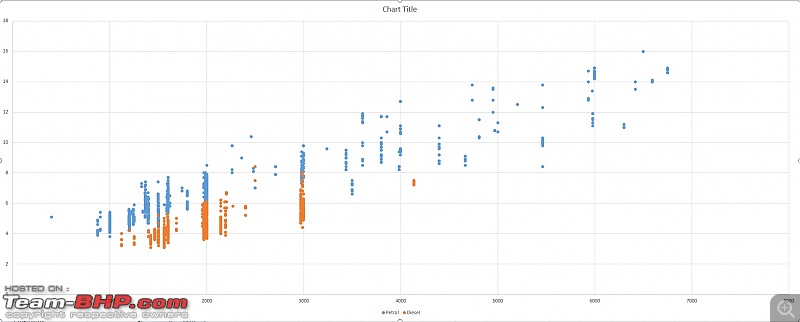 So there we have it. We have looked at NOx+HC, PM, CO, CO2 and fuel consumption, and the only place where CC matters is CO2 and Fuel consumption. In both these areas, petrol engines fare worse than diesel vehicles. Lets hope, future decisions made also look at data rather than whims and fancies. Last edited by tsk1979 : 29th May 2016 at 01:12. | |
| |  (165)
Thanks (165)
Thanks
 |
| The following 165 BHPians Thank tsk1979 for this useful post: | --gKrish--, .anshuman, aaggoswami, abir.scot, Ace F355, Aceman82, achyutaghosh, ACM, Aditya, ajindal, ajman28, ajmat, akp666, Akshay1234, alphadog, ampere, amyth78, antz.bin, Aragorn, aravindkumarp, aravindwarrier, arjithin, aruncheloor, arundeep, ashlil, avdhesh15, Baddychat, Bageera, bblost, bharat4ever, BigBrad, biggrin, blackasta, BlackPearl, BNM, bsdbsd, catchjyoti, Chuckster, cn.vishnu, Contrapunto, cs_rajesh, deepfusion, deetjohn, Desmosedici, dhanushs, Dhar's, DicKy, discoverwild, Divya Sharan, doxinboy, DrANTO, falconion, fiat_tarun, ganeshb, Gosu, GTO, harry10, iamswift, Immix, InControl, IndigoXLGrandDi, iron, Jaggu, Jeash.vk, josebi, jusgetgoing, Karthik Chandra, kiku007, KPS, laferrari, lemedico, Leoshashi, lloydofcochin, lurker, maheshramaling, mallumowgli, man_of_steel, mayankk, mi2n, Mohan Mathew A, moralfibre, Motard_Blr, mpksuhas, mrbaddy, mxx, navin, navpreet318, Nilesh5417, Nitish.arnold, noopster, onedotsix, parsh, PGNarain, phamilyman, phoenixash, Prowler, purohitanuj, R2D2, RaghuVis, rahulrajeev, Rajeevraj, rajess_in, Raj_RD, Ranga, RavenAvi, rednikhil, Rehaan, reignofchaos, Ricky_63, rishie, riturajsharma19, RoadSurfer, RohanDheman, rohitnp, rohitoasis, romeomidhun, rrsteer, Ruchitya, RWD, S2!!!, samm, Samurai, samy1117, Sankar, scopriobharath, sdp1975, shipnil, shourya_lahiri, silversteed, Sisu, SmartCat, sourav9385, spdfreak, Srikanthan, SS-Traveller, ssahadevan, sschivate, stanjohn123, suhaas307, supertinu, sups, suresheadala, suyr, swiftdiesel, swiftnfurious, Tamarind, Teesh@BHP, theexperthand, TheSkinnyDevil, toothless, Turbo Head, Turbohead, unmesh, VaibhaoT, vb-saan, vibbs, Vid6639, Viju, viren83, Vitalstatistiks, Voyager-1, wrongturn, yjagota, ysak, zavegur |
| | #3 |
| Team-BHP Support  | Re: Why engine capacity-based diesel vehicle bans don't make any sense Thread moved from the Assembly Line to the Indian Car Scene. Thanks for sharing! |
| |  (5)
Thanks (5)
Thanks
 |
| The following 5 BHPians Thank GTO for this useful post: | ajayclicks, aruncheloor, Immix, shourya_lahiri, tsk1979 |
| | #4 | |
| Senior - BHPian Join Date: May 2006 Location: Pune
Posts: 1,807
Thanked: 2,595 Times
| Re: Some more data analysis Quote:
 This is an eye opener and i hope someone pushes this analysis to the idiotic news channels that blabber nonsense all day long. Please lets have a 30min slot to discuss something along these lines. In a way, am glad Renault and Fiat sell close to nothing in India. Ditto for VW / Skoda since am sure their engines, given the current scandals, even in India are spewing lot of NoX+HC. I would be so keen to now know how exactly does our national diesel engine fare! Thanks once more! I believe these are the threads that make team-bhp what it is and i immensely enjoy reading through such threads and learning constantly!  Edit: Can you attach some high res plots? I found it hard to follow them even after i opened them in separate windows standalone. I want to re-read the thread since its a lot of information to absorb in just a couple of reads. Last edited by Nilesh5417 : 30th May 2016 at 10:56. | |
| |  (7)
Thanks (7)
Thanks
 |
| The following 7 BHPians Thank Nilesh5417 for this useful post: | adimicra, biggrin, Contrapunto, GTO, InControl, phynix123, vgsr |
| | #5 |
| Senior - BHPian | Re: Why engine capacity-based diesel vehicle bans don't make any sense What is use of having a low Polluting vehicle if pollution load is not a criteria in ban or tax proposals. In UK at least, the tax is based on emission performance, rather than the engine size. That makes more sense as after all we are trying to control pollution and not ban for the sake of banning. This thinking is similar to Delhi Police closing down the shops and restaurants after 11 citing anti social activities, rather than go to the root cause and increase the police presence. This move to ban larger diesel engine sizes in Metros reminds me of a time when the Tax used to be levied on the engine size (displacement) rather than power output. For populist moves it is easier to identify the DEVIL - large Diesel SUV and ban them, rather than have a more rational criteria. |
| |  (3)
Thanks (3)
Thanks
 |
| The following 3 BHPians Thank Aroy for this useful post: | biggrin, GTO, Ranga |
| | #6 |
| Distinguished - BHPian  | Re: Why engine capacity-based diesel vehicle bans don't make any sense Superb analysis, Tanveer. Rated this very informative thread a thoroughly well-deserved 5 stars! A set of very surprising results, indeed! And an eye-opener for all those who thought bigger-sized diesels polluted more than smaller ones. Naturally, bigger-sized engines have better tech and design to burn diesel more efficiently and it's no surprise that they pollute lesser than their smaller-sized counterparts, which are more compact and might see more design-wise compromises. All fuels pollute. Petrols are not going scot-free in this regard. Burning fuel cleanly and efficiently is a big challenge for carmakers today, and claims by Audi & co that synthetic diesel/petrol burns more cleanly and fully than fossil fuel remains to be seen. Till then, we have to do with fossil fuel. About time the NGT and it's associates see this thread and learn something, before issuing blind-bans on engine sizes. And, since the 1.9xx liter diesels pollute the most (as seen in almost all the results), can we infer that Mahindra's 1.99L option for the XUV500/Scorpio AFTER the NCR diesel ban came into effect is actually a bigger contributor to pollution than it's 2.2L counterpart?! Last edited by RavenAvi : 30th May 2016 at 11:02. Reason: added a point |
| |  (2)
Thanks (2)
Thanks
 |
| The following 2 BHPians Thank RavenAvi for this useful post: | biggrin, GTO |
| | #7 |
| Senior - BHPian Join Date: Feb 2005 Location: Melbourne
Posts: 4,376
Thanked: 5,105 Times
| Re: Why engine capacity-based diesel vehicle bans don't make any sense Excellent analysis! We always knew that but now we also have numbers to support our theory. The feasible solution is to tax/ban/destroy based on emissions rather than engine size. It also turns out that a lot of engine are actually eating emissions than destroying the AS-IS environment. P.S. Are these scatter plots created in Excel or some other data visualisation tool? |
| |  (1)
Thanks (1)
Thanks
 |
| The following BHPian Thanks extreme_torque for this useful post: | GTO |
| | #8 |
| BHPian Join Date: Oct 2012 Location: Thane
Posts: 220
Thanked: 1,122 Times
| Re: Why engine capacity-based diesel vehicle bans don't make any sense Amazing work tsk1979! This is the only post which actually did some data analysis. Actually, the supreme court and NGT decisions are based on the mean (i.e. average) of the scatter plots (which would actually be a near upward straight line). However, the devil, in this case, lies in the variance. Since the variance is so high, the engine size would be a poor indicator of the amount of pollution caused. The rules should be framed on the actual level of pollutants measured. |
| |  (1)
Thanks (1)
Thanks
 |
| The following BHPian Thanks ashlil for this useful post: | GTO |
| | #9 |
| BHPian | Re: Why engine capacity-based diesel vehicle bans don't make any sense Post deleted by the Team-BHP Support : Please do NOT post messages that add little or no informational value to the thread. We need your co-operation to maintain the quality of this forum. Please read our rules before proceeding any further. We request you to post ONLY when you have something substantial to add to a discussion. Last edited by GTO : 30th May 2016 at 15:23. |
| |  ()
Thanks ()
Thanks
  |
| | #10 |
| BHPian Join Date: Jul 2007 Location: Montreal Canada
Posts: 444
Thanked: 770 Times
| Re: Why engine capacity-based diesel vehicle bans don't make any sense TSK, you just took off your pants and dropped a massive deuce in the face of NGT and all their pointless claims  Jokes apart, THIS is how we arrive at a useful conclusion, people! Actionable insights, that's the need of the hour. Thank you tsk for giving people exactly what is needed to derive useful conclusions from historical & current data. So, I guess it's safe to say that the NGT & all other pollution controlling bodies in India don't really know how to do their jobs? I recommend our friendly mods for this job  Last edited by Eddy : 30th May 2016 at 11:41. Reason: No animated GIFs please. |
| |  (6)
Thanks (6)
Thanks
 |
| The following 6 BHPians Thank sourav9385 for this useful post: | --gKrish--, biggrin, GTO, InControl, lurker, Whichcarnow |
| | #11 | ||
| Team-BHP Support  | Re: Why engine capacity-based diesel vehicle bans don't make any sense Quote:
Quote:
Due to the huge data set, I know its difficult to read this. However, if you download the data from the website, its trivial to create a scatter plot based on engine size. All the data is freely available. Just download the zip and extract the CSV! | ||
| |  (3)
Thanks (3)
Thanks
 |
| The following 3 BHPians Thank tsk1979 for this useful post: | biggrin, GTO, laferrari |
| |
| | #12 | |
| Distinguished - BHPian  | Re: Why engine capacity-based diesel vehicle bans don't make any sense Quote:
A link to my post: http://www.team-bhp.com/forum/techni...ml#post3109933 Here, I had specifically mentioned the K9K Renault engine as one of the culprits. | |
| |  ()
Thanks ()
Thanks
 |
| | #13 | |
| BHPian Join Date: Nov 2013 Location: TN-22
Posts: 150
Thanked: 139 Times
| Re: Some more data analysis Quote:
 I wish our NGT fellows too perform such qualitative research to arrive at a practical solution, rather than imposing a mindless blanket ban. With explosion in number of large residential apartments, higher capacity diesel engines are used in power generation at those places. What will happen to those engines? Oh! and the garbage dump yards and the fires there - NGT seems to turn a blind eye towards that! Hope some sense prevails within NGT before they implement the ban. P.S: By the way, I'm still waiting for the magic call from my VW dealer to fit the flow transformer in my Vento's 1.6L EA 189 engine! | |
| |  (1)
Thanks (1)
Thanks
 |
| The following BHPian Thanks Srikanthan for this useful post: | GTO |
| | #14 | |
| Senior - BHPian Join Date: Oct 2010 Location: Bangalore
Posts: 1,813
Thanked: 5,864 Times
| Re: Why engine capacity-based diesel vehicle bans don't make any sense Quote:
Also, i regularly see other diesel cars of modern era like i20, duster, etc smoking during acceleration. The smoke is always black and sooty. TSK has kindly provided such an immense technical data, that I am now inclined to believe that the black smoke is not 'so' bad as it looks. It has less CO2, but some more of PM, CO, NOx etc.  My head (which acts on facts) says that the black smoke is not so bad as percieved. My heart, however, says that something which looks so black, will actually be very bad.  Or am I mistaken? | |
| |  (3)
Thanks (3)
Thanks
 |
| The following 3 BHPians Thank abhishek46 for this useful post: | biggrin, cowboy45, GTO |
| | #15 |
| Distinguished - BHPian  | Re: Why engine capacity-based diesel vehicle bans don't make any sense I completely agree with you on the size perspective of these engines  .Size does not matter at all these days.Engine design and technology used such as fuel injection and turbocharging is what matters. .Size does not matter at all these days.Engine design and technology used such as fuel injection and turbocharging is what matters.I for once think that manufacturers should concentrate on improving the technology used in their engines such as fuel injection and states of tune should be tweaked to reduce emissions rather than downsizing altogether in this modern era where we have computers and softwares at our disposal. The NGT ban on 2 litre diesels is useless anyways when 1.3 litre ones emit more.All thanks to the low emission testing standards in our country,I think our government is way behind when it comes to these emission norms  |
| |  (1)
Thanks (1)
Thanks
 |
| The following BHPian Thanks vishy76 for this useful post: | GTO |
 |


